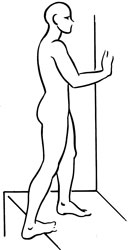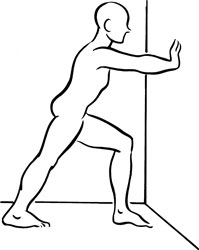Trigger Point Therapy for Myofascial Pain (33 page)
Read Trigger Point Therapy for Myofascial Pain Online
Authors: L.M.T. L.Ac. Donna Finando

Causative or perpetuating factors:
Trigger points occur in this muscle as a result of its placement within the pain referral zone of an associated muscle.
Satellite trigger points:
Rectus femoris, vastus lateralis, vastus medialis, vastus intermedius.
Affected organ system:
Genitourinary system.
Associated zones, meridians, and points:
Ventral zone; Foot Yang Ming Stomach meridian; ST 31, LIV 8.
Stretch exercise:
Digital compressions directly along the muscle produce an effective local stretch.
Strengthening exercise:
Strengthening exercises specific to this muscle are generally not indicated.

Popliteus and trigger point

Popliteus pain pattern
P
OPLITEUS
Proximal attachment:
Lateral aspect of the lateral condyle of the femur.
Distal attachment:
Proximal one-third of the posterior aspect of the tibia.
Action:
Internally rotates the leg on the femur when the thigh is fixed and the leg is free and externally rotates the femur on the leg in weight bearing when the leg is fixed; unlocks the knee joint to facilitate bending of the knee; prevents forward displacement of the femur on the tibia when crouching.
Palpation:
Popliteus forms part of the distal aspect of the floor of the popliteal fossa. Palpate popliteus with the patient side-lying on the affected side, the leg slightly flexed. The distal, medial attachment of the muscle lies on the posterior aspect of the tibia and can be palpated between the tendon of semitendinosus and the medial head of gastrocnemius. To palpate taut bands within this aspect of popliteus, laterally displace the overlying gastrocnemius and soleus. The proximal, lateral end of popliteus lies in the popliteal space just above the head of the fibula, between the tendon of biceps femoris and the lateral head of gastrocnemius and plantaris. Palpate through the overlying musculature.
Pain pattern:
Pain in the back of the knee, often when crouching, running, or walking downhill or going down stairs; inability to straighten the knee fully without pain. Pain from trigger points in this muscle is rarely experienced in isolation; pain is most often experienced in combination with gastrocnemius and biceps femoris, which are usually identified as the source of the posterior knee pain. Once the gastrocnemius and biceps femoris trigger points are reduced, popliteus can be more readily identified as the source of posterior knee pain.
Causative or perpetuating factors:
Muscle overload while braking the forward motion of the femur during a twisting turn, with the body weight on the slightly bent knee of the side to which the body is turning. This is especially common in soccer or football or when running or skiing downhill. Trigger points in popliteus may develop secondary to a tear of the plantaris muscle and may remain long after the plantaris tear is healed.
Satellite trigger points:
Gastrocnemius.
Affected organ systems:
Genitourinary system.
Associated zones, meridians, and points:
Dorsal zone; Foot Tai Yang Bladder meridian; BL 39 and 40.
Stretch exercises:
Flex the leg 15 to 20 degrees; with the thigh fixed, laterally rotate the leg. Make sure that the leg (not the thigh) is being rotated. Hold the position for a count of fifteen to twenty. Repeat two to three times.
Strengthening exercise:
Due to the nature of this muscle, strengthening exercises are not necessary.

Stretch exercise: Popliteus

Gastrocnemius and trigger points
G
ASTROCNEMIUS
Proximal attachment:
By two heads, the medial head attaching to the medial epicondyle of the femur, the lateral head attaching to the lateral epicondyle of the femur.
Distal attachment:
Via the tendocalcaneus (Achilles tendon) to the posterior surface of the calcaneus, with soleus.
Action:
Plantar flexion; aids in flexion of the knee when the leg is not bearing weight.
Palpation:
To locate gastrocnemius, identify the following structures:
- Medial epicondyle of the femur
- Lateral epicondyle of the femur
- Tendocalcaneus (Achilles tendon)âThe thickest and strongest tendon in the body, the tendocalcaneus is the common tendon of insertion for the gastrocnemius and soleus muscles. This tendon is palpable from the lower one-third of the calf to the calcaneus.
Due to its superficial position on the posterior calf, gastrocnemius is easily palpable. Palpate both the medial and lateral heads throughout their course, to their attachment to the tendocalcaneus. Note that the medial head is somewhat longer than the lateral head.

Gastrocnemius pain pattern
Pain pattern:
Local calf pain without reduced range of motion or weakness; pain in the back of the knee; possibly pain in the instep; nocturnal calf cramps.
Causative or perpetuating factors:
Chronic overload due to excessive plantar flexion; immobility of the legs; reduced circulation into the legs.
Satellite trigger points:
Soleus, hamstrings.
Affected organ system:
Genitourinary system.
Associated zones, meridians, and points:
Dorsal zone; Foot Tai Yang Bladder meridian; BL 56, 57, and 58, GB 36.
Stretch exercises:
- Place the ball of the foot on a step or curb and allow the heel of the foot to drop below the level of the step. Keep the knee straight as you stretch the calf. Hold this position for a count of twenty-five to thirty.
- Stand approximately 12 inches from a wall, the hands placed on the wall at the chest level. Place the leg to be stretched approximately 18 inches behind the other, keeping the toes of both feet facing the wall and the feet hip-width apart. Bend the front knee, keeping the rear leg straight. Hold this position for a count of twenty-five to thirty.
Strengthening exercise:
Standing and holding on to a wall or chair for balance, raise up onto the ball of the foot, bringing the heel well off the floor. Hold this position for a count of five. Slowly return the heel to the floor. Repeat ten to twelve times.

Stretch exercise 1: Gastrocnemius

Stretch exercise 2: Gastrocnemius

Soleus and trigger points